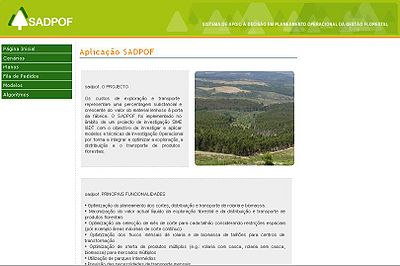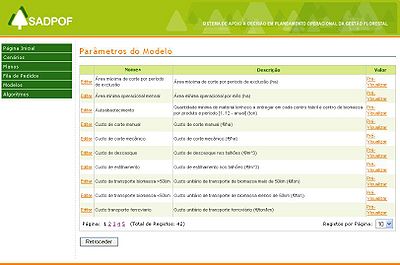Difference between revisions of "SADPOF"
Alexmarques (Talk | contribs) (→General system functioning) |
Alexmarques (Talk | contribs) (→Support for specific issues) |
||
| Line 30: | Line 30: | ||
SADDPOF aims to provide optimized FOP scenarios and facilitate subsequent trade-off analysis. Its current scenarios establish monthly harvest schedules for different wood product assortments as well as its distribution networks from harvest sites to transformation centers, including terminals for intermediate storing. The harvest scheduling sub-problem accounts for spatial constraints, monthly forest roads accessibility and contractual obligations forcing harvest to occur before land rental contract expiration. The distribution sub-problem fulfills the monthly qualified destinations demands and relays on other specific transportation-distribution constraints, like road and railway transportation costs minimization, terminals maximum storing capacity and maximum storing time. | SADDPOF aims to provide optimized FOP scenarios and facilitate subsequent trade-off analysis. Its current scenarios establish monthly harvest schedules for different wood product assortments as well as its distribution networks from harvest sites to transformation centers, including terminals for intermediate storing. The harvest scheduling sub-problem accounts for spatial constraints, monthly forest roads accessibility and contractual obligations forcing harvest to occur before land rental contract expiration. The distribution sub-problem fulfills the monthly qualified destinations demands and relays on other specific transportation-distribution constraints, like road and railway transportation costs minimization, terminals maximum storing capacity and maximum storing time. | ||
| − | Furthermore, its novel technical architecture foresees specific decision support features, such as user’s | + | Furthermore, its novel technical architecture foresees specific decision support features, such as user’s scenario parameterization screens, scenario cloning for creating new scenarios based on existents, scenarios queue for accessing its processing status and automatically triggers simulation and optimization events. The GIS visualization and reporting templates meet the users’ real-life requirements. |
[[Image:diagram_sadpof.jpg|thumb|400px|SADPOF forest tactical/operational planning problems]] | [[Image:diagram_sadpof.jpg|thumb|400px|SADPOF forest tactical/operational planning problems]] | ||
Revision as of 14:32, 11 January 2010
General System description
System name: Sistema de Apoio à Decisão em Planeamento Operacional Florestal
Acronym: SADPOF
Brief overview
Web based application for optimized forest operational planning (FOP). Currently solves harvest scheduling integrated with eucalyptus (Eucalyptus globulus, Labill) wood logs and biomass assortment and assignment, under the scope of an integrated pulp and paper company.
Contents
Scope of the system
SADPOF allows forest practitioners to simulate alternative FOP scenarios and computer economical and ecological scenario evaluation indicators for further scenario comparison. The results of the selected management scenario can be visualized into a GIS integrated module or presented in several pre-defined reports, like the Operational Plan.
System origin
The SADPOF prototype has developed in 2007-2008 in the course of Portuguese funding research project, coordinated by the IT Company Link Consulting [1], with the scientific partnership of Instituto Superior de Agronomia (ISA) [2] and the forest business experts from Grupo Portucel Soporcel [3]. The latter were involved during the entire project and provided real-life requirements and test cases, which motivated the models and optimization algorithms developed by ISA. This prototype was publically presented to the Iberian Forest community during the FOP workshop organized by the partnership.
It is still a work in progress as its current version implements a sub-set of the foreseen SADPOF functionalities. Further developments can include its productization and installation into real-life application cases.
Support for specific issues
SADDPOF aims to provide optimized FOP scenarios and facilitate subsequent trade-off analysis. Its current scenarios establish monthly harvest schedules for different wood product assortments as well as its distribution networks from harvest sites to transformation centers, including terminals for intermediate storing. The harvest scheduling sub-problem accounts for spatial constraints, monthly forest roads accessibility and contractual obligations forcing harvest to occur before land rental contract expiration. The distribution sub-problem fulfills the monthly qualified destinations demands and relays on other specific transportation-distribution constraints, like road and railway transportation costs minimization, terminals maximum storing capacity and maximum storing time.
Furthermore, its novel technical architecture foresees specific decision support features, such as user’s scenario parameterization screens, scenario cloning for creating new scenarios based on existents, scenarios queue for accessing its processing status and automatically triggers simulation and optimization events. The GIS visualization and reporting templates meet the users’ real-life requirements.
Support for specific thematic areas of a problem type
- Silvicultural
- Product Assortment
- Assignment and distribution
- Development choices / land use zoning
Further developments will implement transportation planning and crews scheduling.
Capability to support decision making phases
- Intelligence: SADPOF provides a structure approach to FOP problems as it identifies required information, allows the selection and parameterization of the management goals and constraints. It contributes for capturing existing technical knowledge and generates new decision support basis information through optimized scenarios economical and ecological assessments and trade-offs analysis.
- Design: SADPOF simulates and assesses alternative FOP scenarios related within the goals and constraints selected by users.
- Choice: SADPOF provide optimized solution for each FOP scenario, driving the decision-maker to choose among the best solutions.
- Monitor: SADPOF is restricted to planning purposes. However its integration with operations follow-up system is foreseen, with special interest for adaptive real-time planning features.
Related systems
SADPOF yearly harvesting stands sub-set results from with other strategic forest planning systems, such as SAGfLOR. The scenario characterization information can be resident in other related systems, like the forestland patrimony management system. Currently, SADPOF data canalization relays on pre-defined import formats, although integration interfaces can be developed. Similarly, the pre-defined outputs can feed other systems downstream of the planning process, such as forest services adjudication and operations follow-up systems.
Data and data models
Typical spatial and temporal extent of application
SADPOF it’s a tactical/operational planning systems, encompassing 12 to 36 1-month temporal horizon. It typically deals with forest regional scale problems, although the wood destination network can be national or international.
Forest data input
SADPOF required forest level input data.
- Forest harvesting stand: geographical location, area, forest occupation, harvesting volume estimates at the initial planning period, wood piles geographical location, road accessibility months, contractual obligations, slope level, site index
- Product assortment: type of product, product characteristics
- Transformation center: geographical location, accepted products
- Terminal: geographical location, accepted products
- Distribution network: geographical representation, shortest path transportation distances by road and railway between each origin and destination
Type of information input from user (via GUI)
Describe what is the information that the user directly inputs in the system if any): expert knowledge, opinion, goals and production objectives, preferences, stand/site information.... The user can change pre-defined parameter values in specific GUI:
- Management model parameters:
- Eucaliptus silvicultural system: maximum rotation, minimum harvesting age, installation density
- Annual average growth in each site index
- Economical information: harvesting unitary costs, installation unitary costs (with or without resprout removal) wood product prices per destination, transportation unitary costs, storing costs,
- Minimum qualified monthly demands on the destinations
- Terminals maximum storing capacity and maximum storing time
- Spatial constraints: minimum operational area, maximum operational area, minimum distance between adjacent stands, exclusion period
- Minimum monthly level of stripped and un-stripped wood
- Time horizon, interest rate
- parameters: Maximum number of iterations, Cooling parameters
Models
Forest models
- Eucaliptus wood logs volume and weight growth and yield models
- Eucaliptus biomass prediction models
- Eucaliptus wood logs drying models
Decision Support
Decision-making processes and models
- Operations research modeling
General system functioning
The user starts by creating a new FOP scenario or consulting the scenarios processing status in the Scenarios queue. The FOP scenario includes selecting one model and solution method, their parameters configuration, all the required business data and afterwards, the optimization results. Thus, the users operations in the SADPOF are:
- New FOP scenario creation: selection of the model and solution method
- Scenario parameterization: the model and solution methods have default values, with can be changed by the user.
- Scenario simulation: automatic system operation for decision variable generation and business data canalization. The simulated scenario can be optimized within SAPDOF optimization module or exported to CPLEX.
- Scenario optimization: automatic system operation for solution method execution. Ends with the generation on the Operational Plan and the other SADPOF outputs.
- Scenario cloning: corresponds to the exact replication of a selected scenario (model, solution method, business data, parameters) on the created or simulated status. This feature enables rapid new scenario creation for further parameterization, aiming scenarios comparison.
- Scenario analysis: the scenario optimization results can support profitability assessments and trade-off analysis.
- Scenario queue consultation: presents the status of each FOP scenario and their direct link. Several scenarios can be created almost simultaneously. Their processing sequence is automatically managed by the Scenario queue.
- Operational plan consultation
Output
Types of outputs
The results of the selected management scenario can be visualized into a GIS integrated module or presented in several pre-defined reports, like the Operational Plan. This excel report presents monthly harvest schedules and monthly qualified wood flows between the origins and destinations, in order to maximize the forest operations net present value (NPV) and to fulfill the management objectives and constraints. It further expresses the scenario optimization results summary which can be used to perform scenario profitability analysis (e.g., individual NPV contributions of harvest transportation from stands and transportation from terminals into the final NPV result, limiting and non-limiting constraints, obtained vs. target deviations for the limiting constraints, weights and penalties given to each unitary deviation). Additionally, trade off analysis can be performed, through generating identical scenarios, changing some model parameters and conducting their optimized results comparison (e.g. impact of terminal capacities increment, existence/value of transformation centers self-supply levels, existence/level of terminals minimum level of supply, increasing the penalty of the maximum area limitation constraint, existence/value of the terminals maximum storing time, wood product prices variation in some destinations, operations costs variations, inaccessibility of the forest roads for some stands during winter).
Spatial analysis capabilities
- integrated capabilities in the SADPOF GIS module
- facilitates links to other GIS systems
System
System requirements
- Client requirements:
- Browser with web connectivity
- Minimum Windows XP (GIS module)
- Server requirements:
- Windows Server 2003
- SQL Server 2005
- .Net 3.5
- 1 GB memory
- minimum Duo Core Processor
Architecture and major DSS components
The forest practitioners were involved during the entire project, particularly at SADPOF architecture and specification, using the Enterprise Architecture approach [4][5]
The SADPOF three layer modular architecture encompasses the common business information and scenario data repositories, the GUI interfaces for the several FOP application modules and their specific simulator and optimizer component. Visual Studio 2008 (C#) is the SADPOF developing environment, except for the GIS module implemented in Open Source MapWinGis [[6]] [6]
Usage
Currently it has research use.
Installation
- It requires prior user training on the SADPOF concepts.
- Demo: trial and demo versions can be given by request alexmarques@isa.utl.pt.
References
Cited references
- ↑ Marques, A. F., Borges, J.G., Gonçalves, L., Romano, M., 2009. A hybrid approach for integrating harvest scheduling and product assortment and assignment to transformation centers. Forest Science (under preparation)
- ↑ http://lpsolve.sourceforge.net/5.5/
- ↑ http://ftp.ilog.fr/products/cplex/product/mip.cfm
- ↑ Marques, A. F., Borges, J.G., Sousa, P., Pinho, A., 2009. PulpWood Supply Chain Architecture. An application in Portugal. European Journal of Forest Research (submitted)
- ↑ Marques, A. F., Borges, J.G., Sousa, P., Moura, P., Ferrinho, M., 2009. Designing computerized systems to support operational forest management planning. Computer and Electronics in Agriculture (prep)
- ↑ http://www.mapwindow.org


